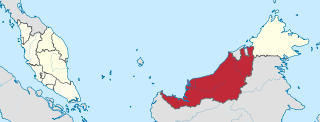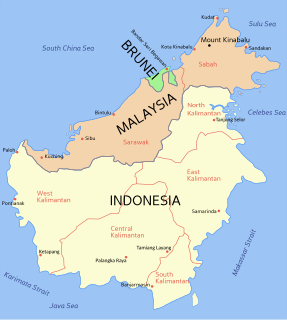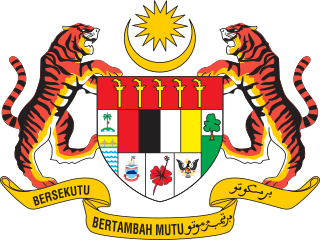
Sarawak is a Borneo state within Malaysia. The largest among the 13 states, with an area almost equal to that of Peninsular Malaysia, Sarawak is located in northwest Borneo Island, and is bordered by the Malaysian state of Sabah to the northeast, Kalimantan to the south, and Brunei in the north. The capital city, Kuching, is the largest city in Sarawak, the economic centre of the state, and the seat of the Sarawak state government. Other cities and towns in Sarawak include Miri, Sibu, and Bintulu. As of the 2021 census, the population of Sarawak was estimated more than 3,248,100. Sarawak has an equatorial climate with tropical rainforests and abundant animal and plant species. It has several prominent cave systems at Gunung Mulu National Park. Rajang River is the longest river in Malaysia; Bakun Dam, one of the largest dams in Southeast Asia, is located on one of its tributaries, the Balui River. Mount Murud is the highest point in Sarawak.

East Malaysia, also known as Sabah, Sarawak and Labuan or Malaysian Borneo, is the part of Malaysia on and near the island of Borneo, the world's third largest island. It consists of the Malaysian states of Sabah and Sarawak, as well as the Federal Territory of Labuan. Labuan is an island in a small archipelago near the coast of Sabah. East Malaysia lies to the east of Peninsular Malaysia, the part of the country on the Malay Peninsula. The two are separated by the South China Sea.

The national flag of Malaysia, also known as the Stripes of Glory, is composed of a field of 14 alternating red and white stripes along the fly and a blue canton bearing a crescent and a 14-point star known as the Bintang Persekutuan. The 14 stripes, of equal width, represent the equal status in the federation of the 13 member states and the federal territories, while the 14 points of the star represent the unity between these entities. The crescent represents Islam, the country's state religion; the blue canton symbolises the unity of the Malaysian people; the yellow of the star and crescent is the royal colour of the Malay rulers.

The states and federal territories of Malaysia are the principal administrative divisions of Malaysia. Malaysia is a federation of 13 states (Negeri) and 3 federal territories.

Public holidays in Malaysia are regulated at both federal and state levels, mainly based on a list of federal holidays observed nationwide plus a few additional holidays observed by each individual state and federal territory. The public holidays are a mix of secular holidays celebrating the nation and its history, and selected traditional holidays of the various ethnic and religious groups that make up the country.

Independence Day, is the official independence day of Malaysia. It commemorates the Malayan Declaration of Independence of 31 August 1957, and is defined in Article 160 of the Constitution of Malaysia. The day is marked by official and unofficial ceremonies and observances.

The Sarawak United Peoples' Party, or SUPP is a multi-racial political party of Malaysia based in Sarawak. The SUPP president is Dr. Sim Kui Hian. He succeeded the post from his predecessor, Peter Chin Fah Kui in 2014. Established in 1959, SUPP is the first political party in Sarawak. It has its roots in left-leaning ideologies, nationalism and championing for the cause of the working class. Formerly it was one of the Sarawak component members of Barisan Nasional from 1970 until June 2018. Together with other Sarawak-based BN component parties, SUPP always has had tension in its relationship with its Peninsula-based partners. After the 2018 general election defeat of BN had proven that the model was no longer viable, and following a key meeting between all Sarawak-based BN coalition parties on 12 June 2018, SUPP has decided to leave BN to co-form a new Sarawak-based coalition of Gabungan Parti Sarawak.

Malaysian nationality law is the law of Malaysia that deals with citizenship and other forms of nationality. This law is established in Articles 14 to 31 of the Constitution of Malaysia.

Malaysia is a country in Southeast Asia. The federal constitutional monarchy consists of thirteen states and three federal territories, separated by the South China Sea into two regions, Peninsular Malaysia and Borneo's East Malaysia. Peninsular Malaysia shares a land and maritime border with Thailand and maritime borders with Singapore, Vietnam, and Indonesia. East Malaysia shares land and maritime borders with Brunei and Indonesia and a maritime border with the Philippines and Vietnam. Kuala Lumpur is the national capital, largest city and the seat of the legislative branch of the federal government. The nearby planned capital of Putrajaya is the administrative capital, which represents the seat of both the executive branch and the judicial branch of the federal government. With a population of over 32 million, Malaysia is the world's 45th-most populous country. The southernmost point of continental Eurasia is in Tanjung Piai. In the tropics, Malaysia is one of 17 megadiverse countries, home to numerous endemic species.

Merdeka is a term in Indonesian and Malay means "independent" or "free". It is derived from the Sanskrit maharddhika (महर्द्धिक) meaning "rich, prosperous and powerful". In the Indonesian archipelago, this term had acquired the meaning of a freed slave.

Malaysia Day is a public holiday held on 16 September every year to commemorate the establishment of the Malaysian federation on that date in 1963. This event saw Malaya, North Borneo, Sarawak, and Singapore unite into a single state. Singapore, however, was expelled from the federation less than two years later, on 9 August 1965.

The 20-point agreement, or the 20-point memorandum, is a list of 20 points drawn up by North Borneo, proposing terms for its incorporation into the new federation as the State of Sabah, during negotiations prior to the formation of Malaysia. In the Malaysia Bill of the Malaysia Agreement some of the twenty points were incorporated, to varying degrees, into what became the Constitution of Malaysia; others were merely accepted orally, thus not gaining legal status. The 20-point agreement often serves as a focal point amongst those who argue that Sabah's rights within the Federation have been eroded over time.

The history of Sabah can be traced back to about 23–30,000 years ago when evidence suggests the earliest human settlement in the region existed. The history is interwoven with the history of Brunei and the history of Malaysia, which Sabah was previously part of and is currently part of respectively. The earliest recorded history of Sabah being part of any organised civilisation began in the early 15th century during the thriving era of the Sultanate of Brunei. Prior to this, early inhabitants of the land lived in predominantly tribal societies, although such tribal societies had continued to exist until the 1900s. The eastern part of Sabah was ceded to the Sultan of Sulu by the Sultan of Brunei in 1658 for the former helping a victory over Brunei enemies, but many sources stated it had not been ceded at all. By the late 19th century, both territories previously owned by Sultan of Brunei and Sultan of Sulu was granted to British syndicate and later emerged as British North Borneo under the management of the North Borneo Chartered Company. Sabah became a protectorate of the United Kingdom in 1888 and subsequently became a Crown colony from 1946 until 1963, during which time it was known as Crown Colony of North Borneo. On 16 September 1963, Sabah merged with Malaya, Sarawak and Singapore to form Malaysia.

The anti-cession movement of Sarawak was a movement in Sarawak to fight against the British attempt to govern Sarawak as a crown colony rather than a protectorate ruled by the White Rajahs. The movement lasted from 1 July 1946 until March 1950.

The Malaysia Agreement or the Agreement relating to Malaysia between United Kingdom of Great Britain and Northern Ireland, Federation of Malaya, North Borneo, Sarawak and Singapore (MA63) was the agreement which combined North Borneo, Sarawak, and Singapore with the existing states of the Federation of Malaya, the resulting union being named Malaysia. Singapore was later expelled from Malaysia, becoming an independent state on 9 August 1965.

The Proclamation of Malaysia was a statement, written in English and Malay, that declared the merger of the Federation of Malaya with the British crown colonies of North Borneo, Sarawak and Singapore into the new Federation of Malaysia, following the enactment of the Malaysia Agreement and the Malaysia Act 1963 that July. The merger came into effect on 16 September 1963, and the proclamation was delivered on that date by Prime Minister Tunku Abdul Rahman in the Stadium Merdeka in Kuala Lumpur.

The Crown Colony of North Borneo was a British Crown colony on the island of Borneo established in 1946 shortly after the dissolution of the British Military Administration. The Crown Colony of Labuan joined the new Crown Colony during its formation. It was succeeded as the state of Sabah through the formation of the Federation of Malaysia on 16 September 1963.

North Borneo Self-government Day is a self-government day celebrated on 31 August every year by the state of Sabah in Malaysia. Since 2012, the holiday has been received widely by the Sabah state government and the citizens of Sabah, as the Hari Merdeka was not the right celebration day for the state.
Sarawak exhibits notable diversity in ethnicity, culture, and language. The Sarawakian culture has been influenced by Bruneian Malays of the coastal areas. Substantial cultural influences also came from the Chinese and British cultures.

On 4 April 2019, a bill proposing an amendment to the Constitution of Malaysia was tabled in the Dewan Rakyat of the Parliament of Malaysia. The bill proposes to amend Article 1(2) so as to restore the status of the two East Malaysian states of Sabah and Sarawak according to the original content of Malaysia Agreement that was signed in 1963.


















